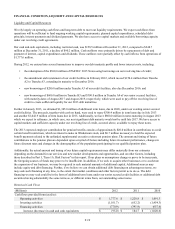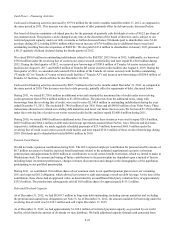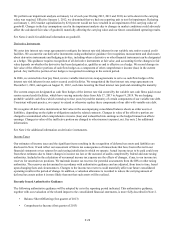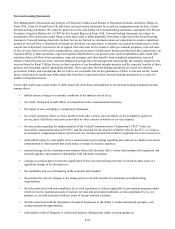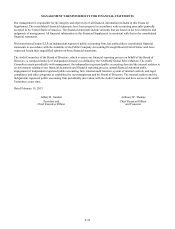Windstream 2012 Annual Report Download - page 124
Download and view the complete annual report
Please find page 124 of the 2012 Windstream annual report below. You can navigate through the pages in the report by either clicking on the pages listed below, or by using the keyword search tool below to find specific information within the annual report.
F-26
Reconciliation of non-GAAP financial measures
From time to time, we will reference certain non-GAAP measures in our filings. Management’s purpose for including these
measures is to provide investors with measures of performance that management uses in evaluating the performance of the
business. These non-GAAP measures should not be considered in isolation or as a substitute for measures of financial
performance reported under GAAP. Following is a reconciliation of non-GAAP financial measures to the most closely related
financial measure reported under GAAP referenced in this filing.
Operating income before depreciation and amortization to GAAP operating income:
(Millions) 2012 2011 %
Operating income $ 887.5 $ 963.5
Depreciation and amortization 1,297.6 847.5
OIBDA (a) $ 2,185.1 $ 1,811.0 21%
(a) OIBDA is defined as operating income plus depreciation and amortization expense. Management believes this measure
provides investors with insight into the core earnings capacity of providing telecommunications services to its
customers.
Critical Accounting Policies and Estimates
We prepare our consolidated financial statements in accordance with accounting principles generally accepted in the United
States. Our significant accounting policies are discussed in detail in Note 2. Certain of these accounting policies, as discussed
below, require management to make estimates and assumptions about future events that could materially affect the reported
amounts of assets, liabilities, revenues and expenses and disclosure of contingent assets and liabilities. We believe that the
estimates, judgments and assumptions made when accounting for the items described below are reasonable, based on
information available at the time they are made. However, there can be no assurance that actual results will not differ from
those estimates.
Revenue Recognition
We recognize revenues and sales as services are rendered or as products are sold in accordance with authoritative guidance on
revenue recognition. Service revenues are recognized over the period that the corresponding services are rendered to customers.
Revenues derived from other telecommunications services, including interconnection, long distance and enhanced service
revenues are recognized monthly as services are provided. Revenue from sales of indefeasible rights to use fiber optic network
facilities ("IRUs") and the related telecommunications network maintenance arrangements is generally recognized over the term
of the related lease or contract. Sales of communications products including customer premise equipment and modems are
recognized when products are delivered to and accepted by customers. Fees assessed to communications customers for service
activation are deferred upon service activation and recognized as service revenue on a straight-line basis over the expected life
of the customer relationship in accordance with authoritative guidance on multiple element arrangements. Certain costs
associated with activating such services are deferred and recognized as an operating expense over the same period.
We recognize certain revenues pursuant to various cost recovery programs from state and federal USF. Revenues are calculated
based on our investment in our network and other network operations and support costs. We have historically collected the
revenues recognized through this program; however, adjustments to estimated revenues in future periods are possible. These
adjustments could be necessitated by adverse regulatory developments with respect to these subsidies and revenue sharing
arrangements, the determination of recoverable costs, or decreases in the availability of funds in the programs due to increased
participation by other carriers.
Allowance for Doubtful Accounts
In evaluating the collectability of our trade receivables, we assess a number of factors, including a specific customer’s ability to
meet its financial obligations to us, as well as general factors, such as the length of time the receivables are past due and
historical collection experience. Based on these assumptions, we record an allowance for doubtful accounts to reduce the
related receivables to the amount that we ultimately expect to collect from customers. If circumstances related to specific
customers change or economic conditions worsen such that our past collection experience is no longer relevant, our estimate of
the recoverability of our trade receivables could be further reduced from the levels provided for in the consolidated financial
statements.





